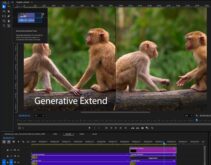 Today, Adobe revealed Creative Suite 5 (CS5). Like many members of the press, I’ve been working with beta software for about three months, and I am very familiar with the additions to Premiere Pro, OnLocation, Media Encoder and a couple of ancillary programs, which I’ll detail here. For information about After Effects, Photoshop or other programs in the suite, you’ll have to look elsewhere.
Today, Adobe revealed Creative Suite 5 (CS5). Like many members of the press, I’ve been working with beta software for about three months, and I am very familiar with the additions to Premiere Pro, OnLocation, Media Encoder and a couple of ancillary programs, which I’ll detail here. For information about After Effects, Photoshop or other programs in the suite, you’ll have to look elsewhere.
At a high level, the improvements to this corner of the suite concentrate in two areas: performance and metadata. Let’s talk performance first. Since the Apple iPad shipped about two weeks ago, there’s been a general surfeit of glowing adjectives on the Internet and in print, and we’ve all become somewhat immune to terms such as “amazing,” “fantastic,” and “astounding” (let’s call it the “iPad effect”). So I’ll be objective and descriptive, rather than literary.
Contents
 Adobe Premiere Pro CS5
Adobe Premiere Pro CS5
Specifically, if you’re working with H.264-based footage, such as footage shot with the Canon EOS 7D or AVCHD camcorders, you could see a drop in rendering time of as much 95 percent. Specifically, in one of my tests, which involved a 20-minute ballet audition video, rendering time of the 7D footage dropped from 84:45 (min:sec) to 3:57 on a 12-core HP Z800. At the risk of adding to the iPad effect, that’s simply astounding.
 What produces this speed increase? Three components: the Mercury Playback Engine; graphics processing unit (GPU) acceleration; and a new, much higher-performance H.264 codec from third-party codec vendor and Adobe supplier MainConcept. Briefly, the Mercury Engine is a brand assigned to a collection of three software improvements: 64-bit native code, the greater memory addressing that this enables, and superior multiple-core CPU use. Yes, you can only run CS5 on a 64-bit system (as has been reported for awhile now) and you’ll need gobs of RAM—I’d say at least 16GB, perhaps as much as 24GB—to really see the benefits. More on that below.
What produces this speed increase? Three components: the Mercury Playback Engine; graphics processing unit (GPU) acceleration; and a new, much higher-performance H.264 codec from third-party codec vendor and Adobe supplier MainConcept. Briefly, the Mercury Engine is a brand assigned to a collection of three software improvements: 64-bit native code, the greater memory addressing that this enables, and superior multiple-core CPU use. Yes, you can only run CS5 on a 64-bit system (as has been reported for awhile now) and you’ll need gobs of RAM—I’d say at least 16GB, perhaps as much as 24GB—to really see the benefits. More on that below.
Adobe OnLocation CS5
The second component, GPU acceleration, only works if you have a supported Nvidia graphics card in your computer (check the Adobe website for compatible cards). Depending upon where you look, GPU acceleration has been described as part of the Mercury engine, and has also been called CUDA technology, since that’s Nvidia’s brand for the underlying technology. Here’s Wikipedia’s explanation:
“CUDA (an acronym for Compute Unified Device Architecture) is a parallel computing architecture developed by Nvidia. CUDA is the computing engine in Nvidia graphics processing units or GPUs that is accessible to software developers through industry standard programming languages.”
Figure 1. The little icon on the left in Premiere Pro CS5 tells you that the effect is GPU accelerated.
Basically, that means that CUDA lets software developers such as Adobe access the graphics card to accelerate certain functions, such as preview and rendering. New in Premiere Pro CS5 are little icons to the right of some effects that tell you whether they are accelerated, or work in 32-bit or YUV space. If they are accelerated, and you have the right Nvidia card in your system, the GPU will render the effect when you apply it to your project, generally in realtime. You can see all the color-correction-related effects that are accelerated in Figure 1; in addition, the new Ultra greenscreen that Adobe added to Premiere Pro is also accelerated, as are overlays like titles, scaling effects (such as picture-in-picture effects) and many others.
This means that you can apply these effects and preview immediately, without rendering (I know, that’s redundant, but I’m trying to avoid adding to the iPad effect by being painfully clear). Perhaps even more important (and pay attention here), the GPU accelerates the application of these effects during rendering to your final output format. So assume you’re producing a project for 720p upload to YouTube in H.264 format, and you’ve applied the Fast Color Corrector effect, an Ultra chroma key effect, a title, and a picture in picture or two.
In CS4, Premiere Pro would have to render these effects using the computer’s CPU before handing off the rendered frames to Adobe Media Encoder for rendering to H.264, which could (and often did) take hours. In CS5, with a supported Nvidia graphics card, the GPU does all this work, generally in realtime or faster, speeding the process and freeing the CPU for other tasks. To be clear, in both versions, Media Encoder is taking the rendered frames from Premiere Pro (or PProHeadless, the background program that steps in for Premiere Pro to perform such renders), and producing the H.264 file using solely the CPU, but the rendering of the timeline itself to hand off to Media Encoder is GPU accelerated in CS5.
Figure 2. CS5 sings on a multicore computer such as HP’s 12-core Z800.
The third leg of the performance stool is a new H.264 codec from MainConcept. Anyone who’s ever worked with H.264 source footage in Premiere Pro in the past knows that it can be incredibly painful, especially for those foolish enough to try on a 32-bit computer. In CS5, the 32-bit option in gone, but those with 64-bit systems and lots of RAM will be rewarded with (being careful here) substantial drops in encoding time. For example, with one 53-minute, single-camera AVCHD shoot, rendering to H.264 for upload to YouTube took 3 hours and 47 minutes in CS4, 31:28 (min:sec) in CS5, both on the same HP 12-core Z800 workstation. That’s a remarkable difference (sorry, a slip, won’t happen again).
Obviously, a big part of that time saving relates to more efficient CPU use. As you can see in Figure 2, CS5 gets the most out of all cores of my 12-core Z800, shown operating with Hyper-Threading Technology (HTT) enabled, hence 24 separate processes averaging 90 percent use. You can also see the genesis of my RAM recommendations—in the Figure, the system was using 14GB, and Media Encoder and PProHeadless were the only two programs running.
Figure 3. Adobe Story, the start of the script-to-screen metadata workflow.
Script-to-screen metadata workflow
The other main aspect of the Adobe CS5 release is the script-to-screen metadata workflow, which starts in Adobe Story, a script-development program that’s part of Adobe’s new CS Live services, which are online products and/or services that are separate from CS5. Though they’re free for now, Adobe may later charge for Story or any other CS Live services.
RELATED LINKS
As has been the case over the past few years, Adobe chose NAB to announce its latest Creative Suite, now in version 5 (CS5)…
New Performance Features in Premiere Pro CS5
Adobe’s Mercury engine will use GPUs to provide better playback in editing software…
HP 12-core Z800 Test Drive, Part 1
I’ve had the pleasure of working with HP’s quad-core, dual-processor Z800 for much of the last 12 months…
I recently spent about a month with the Canon EOS 7D solely evaluating its video quality, and the results were impressive…
You create your script in Story, including descriptive scene-based information and data about the characters. You can export the script into a file that you can import into OnLocation, which preserves all the metadata. You create your shot list in OnLocation, as before, but now you can import clips shot with an untethered camera into OnLocation and link the clips to the shot placeholders, which attaches the metadata to the clip. From there, you can import the clips into Premiere Pro with metadata intact, and pass the script and associated metadata out to Flash during rendering.
There are many little extras in most of the programs; I’ve already mentioned Ultra, which is a great addition. One thing that doesn’t come with the new version is instability. I ran Premiere Pro through 20 or so real-world and synthetic projects during my testing and remember few crashes, if any. Stability is supposedly one of the benefits of 64-bit operation, and it seems to ring true in this case. So CS5 won’t overwhelm you with new features, but the performance boost for those editing in or producing to H.264-based formats could truly be startling (sorry, last time) and the program feels at least as stable as the version it replaces, if not more so. In a different time, I would throw a few more adjectives at you, but at this point, I’ll just let these facts speak for themselves.
 Streaming Learning Center Where Streaming Professionals Learn to Excel
Streaming Learning Center Where Streaming Professionals Learn to Excel





 Adobe Premiere Pro CS5
Adobe Premiere Pro CS5





